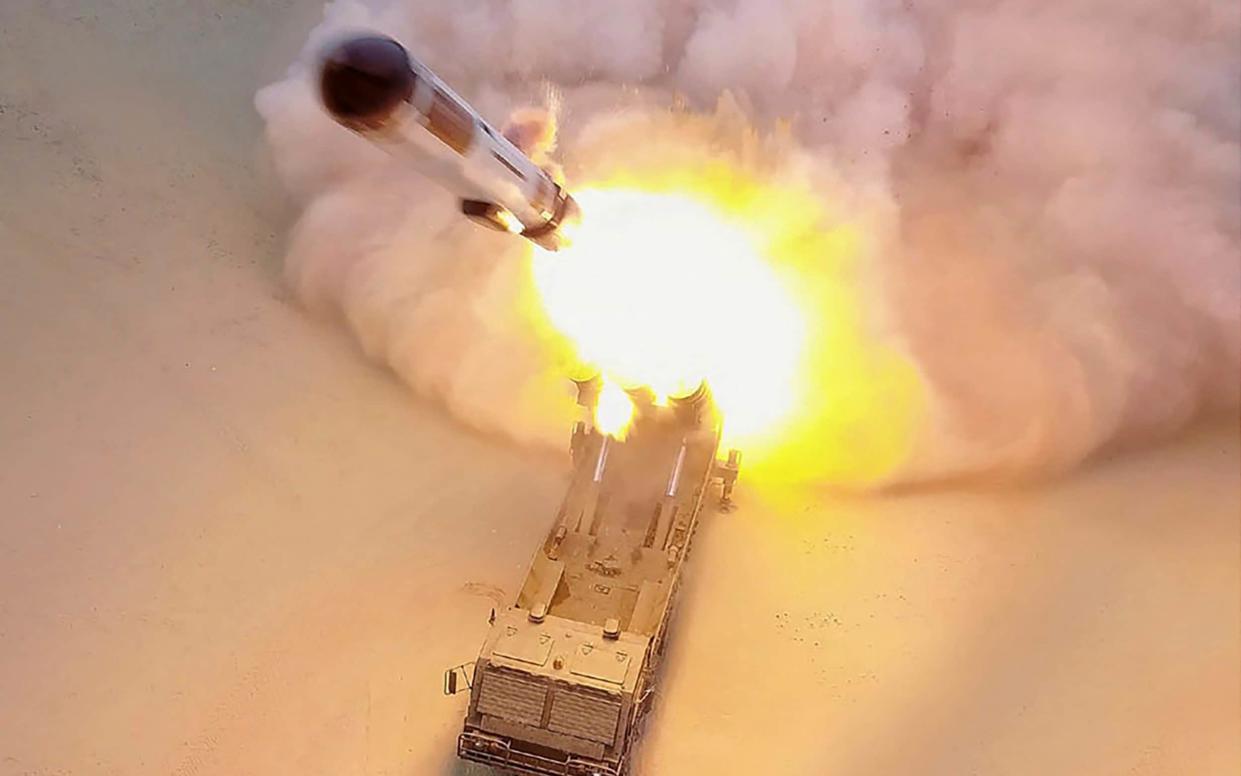North Korea threatens return to nuclear brinkmanship after record spike in missile tests

North Korea has started the year with an unprecedented flurry of January missile launches, squeezing six weapons tests into a month in what appears to be an effort to fulfil leader Kim Jong-un’s pledge to modernise the country’s war deterrents regardless of international sanctions.
Pyongyang conducted two tests this week alone. One on Tuesday involved long-range cruise missiles that hit a "target island 1,800 km away" in the East Sea – also known as the Sea of Japan - while another on Thursday was of "tactical guided missiles", according to the official Korean Central News Agency
For the first time in nearly two years, Kim has even begun making personal appearances at the tests once again.
On Friday, KCNA ran photographs showing the leader wearing his usual long black leather jacket and surrounded by uniformed officials as he inspected a munitions factory that produces "a major weapon system".

Earlier this month, he was pictured donning a familiar pair of binoculars to personally oversee a reported hypersonic missile being launched. Hypersonic missiles, whose increased manoeuvrability makes it difficult to intercept, are listed among the “top priority” tasks for the country’s strategic weapons development.
Russia on Friday said that there was still a chance for six-way talks on North Korea to resume.
But the most intense single-month barrage of missiles on record has raised fears of a fresh crisis on the Korean Peninsula.
A statement by the ruling politburo last week warned of “long-term confrontation” with “US imperialists,” reviving concerns of a return to the brinkmanship of 2017 when then US President Donald Trump threatened “fire and fury” against “little rocket man” and Pyongyang mocked him as a “mentally deranged dotard.”
The question perplexing analysts is, why so many tests now?
One explanation is that Pyongyang is merely following up on Kim’s directive to produce powerful, modern weapons to improve the country’s military capabilities.
At the launch of his five-year plan at a key Party Congress in 2021, the leader said: "The increasingly unstable military environment on the Korean Peninsula and international politics have instigated calls to vigorously push forward with our national defence build-up plans without any delay,"
During the visit to the munitions factory this week, he echoed that sentiment, saying the facility "holds a very important position and duty in modernising the country's armed forces," according to KCNA.
“There have been a mix of both developmental tests and operational exercises this month,” said Ankit Panda, of the Carnegie Endowment for International Peace. “The broader picture is that Kim continues to modernise his capabilities per the agenda he outlined.”
The spike in launches could simply be about Pyongyang’s military “keeping their swords sharp” in step with other countries in the region, agreed John Delury, a professor at Seoul's Yonsei University.

But it could also be a way of provoking a reaction amid a three-year impasse in nuclear talks and fresh sanctions imposed by Washington earlier this month.
“Kim Jong-un is testing the waters with Washington, Beijing and Seoul, and seeing what sort of responses each step elicits,” said Mr Delury.
Crucially, it still leaves “wiggle room” to come back to the table after negotiations collapsed at a summit in Hanoi between Kim and Mr Trump in February 2019.
“If I was advising the Biden administration, I would say bite and see where it goes because we know that sanctions and censure don’t get the North Koreans to do what you want them to do,” he added.
Another significant factor is North Korea’s deteriorating domestic situation, say experts.
This time of year normally sees the military conduct its “Winter Training Cycle”, which involves individual and unit-level training of a force of over one million, but with soldiers going hungry and the country’s pandemic status unknown, the missile launches could be a distraction tactic.

“It could be the case that concern about the pandemic has downsized these exercises and, to shore up morale and continue developing capability, the North Koreans have opted to focus on missile launches,” said Ankit Panda.
“Kim Jong Un is celebrating his tenth year as leader, and after a challenging two years domestically as a result of Covid, extreme weather, ongoing economic issues, missile tests now are a way of signalling internally regime successes,” said Cristina Varriale, a research analyst at the Royal United Services Institute.
Finally, there’s the China factor.
While North Korea’s neighbour and largest trading partner has pushed for the easing of sanctions and recently restarted cross-border trade, few believe Beijing is actively endorsing Pyongyang’s tests.
But Kim’s regime could be rushing them through to avoid impacting the Winter Olympics because of his “favourable relationship” with China, said Ms Varriale.
The proof of that theory will be borne out if the weapons tests stop come Feb. 4. Until then, Kim will keep the world guessing about his next move.

 Yahoo News
Yahoo News 
